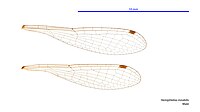Hemiphlebia mirabilis
| Ancient greenling | |
|---|---|
 | |
| mating pair | |
Conservation status | |
| Scientific classification | |
| Domain: | Eukaryota |
| Kingdom: | Animalia |
| Phylum: | Arthropoda |
| Class: | Insecta |
| Order: | Odonata |
| Suborder: | Zygoptera |
| Family: | Hemiphlebiidae Kennedy, 1920[4] |
| Genus: | Hemiphlebia Selys, 1869[3] |
| Species: | H. mirabilis |
| Binomial name | |
| Hemiphlebia mirabilis | |
 | |
Hemiphlebia mirabilis, commonly known as the ancient greenling,[5] is a species of damselfly, the only living species of the genus Hemiphlebia and the family Hemiphlebiidae.[6][7] It is very small with a long, metallic-green body and clear wings. It is endemic to south-eastern Australia. Its natural swamp habitat is threatened by habitat loss. The oldest representatives of the family date to the Late Jurassic.
Distribution and habitat
The ancient greenling has been recorded from a small number of scattered sites, including on King Island and in Mount William, Tasmania; in Wilsons Promontory National Park and near Yea, Victoria; and in Piccaninnie Ponds Conservation Park in south-eastern South Australia. Its recorded habitat includes permanent freshwater ponds, riverine lagoons and swamps that may dry out seasonally.[1] A favoured site discovered in 2008, Long Swamp in the Discovery Bay Coastal Park of south-western Victoria, contains extensive areas of twig-rush (Baumea sp.) which is seasonally flooded but dries out by late summer[8][5]
Conservation
The greenling's conservation status was raised from Vulnerable to Endangered in 2008 because of the limited area of habitat occupied, as well as the small and scattered character of the populations, at least some of which were in decline.[1]
Gallery
-
 Female wings
Female wings -
 Male wings
Male wings
References


- ^ a b c Dow, R.A. (2019). "Hemiphlebia mirabilis". IUCN Red List of Threatened Species. 2019: e.T9891A14278529. doi:10.2305/IUCN.UK.2019-2.RLTS.T9891A14278529.en. Retrieved 16 November 2021.
- ^ Selys-Longchamps, E. (1869). "Diagnose d'un nouveau genre d'Agrionine". Annales de la Société Entomologique de Belgique (Comptes-rendus) (in French). 11: lxxi-lxxiv [lxxiii] – via Biodiversity Heritage Library.
- ^ Selys-Longchamps, E. (1869). "Diagnose d'un nouveau genre d'Agrionine". Annales de la Société Entomologique de Belgique (Comptes-rendus) (in French). 11: lxxi-lxxiv [lxxii] – via Biodiversity Heritage Library.
- ^ Kennedy, C.H. (1920). "The phylogeny of the Zygopterous dragonflies as based on the evidence of the penes". Ohio Journal of Science. 21 (1): 19–29 [25] – via Biodiversity Heritage Library.
- ^ a b Theischinger, Günther; Hawking, John (2006). The Complete Field Guide to Dragonflies of Australia. CSIRO Publishing. p. 22. ISBN 0-643-09073-8.
- ^ Vasilenko, D. V. (2005). "New damselflies (Odonata: Synlestidae, Hemiphlebiidae) from the Mesozoic Transbaikalian locality of Chernovskie Kopi" (PDF). Paleontologicheskii Zhurnal. 39 (3): 280.
- ^ "Species Hemiphlebia mirabilis Selys, 1869". Australian Faunal Directory. Australian Biological Resources Study. 2013. Retrieved 30 March 2017.
- ^ Richter, Reiner (2010-06-18). "Discovery of New Populations of Hemiphlebia mirabilis (Ancient Greenling)" (PDF). Author. Retrieved 2011-03-26.
- v
- t
- e
- Kingdom: Animalia
- Phylum: Arthropoda
- Class: Insecta
- Subclass: Pterygota
- Superorder: Odonatoptera
Suborder Zygoptera | |||||||||
|---|---|---|---|---|---|---|---|---|---|
| |||||||||
Suborder Epiprocta | |||||||||||||
|---|---|---|---|---|---|---|---|---|---|---|---|---|---|
| |||||||||||||














